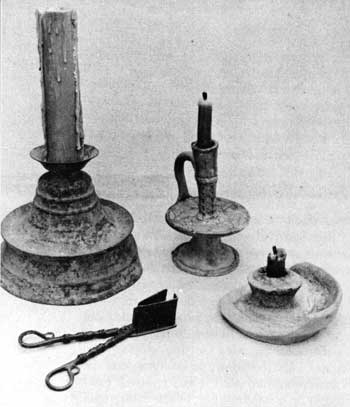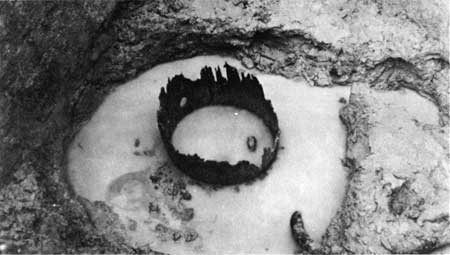|
JAMESTOWN National Historic Site |
 |
Colonial Parkway
This 23-mile scenic motor road connects historic Jamestown, Williamsburg, and Yorktown. Along its course are descriptive markers that give bits of history which often show the interrelation of Jamestown (where the Nation began), Williamsburg (the 18th-century capital of Virginia where important elements of our Revolutionary leadership were nourished), and Yorktown (where the climatic battle in our struggle for independence was fought).
The Study of Jamestown
When the major part of Jamestown Island, including much of the town-site, was placed in its custody in 1934, the National Park Service, working with the Association for the Preservation of Virginia Antiquities, assumed responsibility for preservation of the historic remains on the island and for interpreting the sire. This posed many problems, for the Jamestown story is a vital segment of our national history, involving the origins and growth of the culture of this formative period of English colonization. The first pressing concern was the accumulation of data on which to base a more complete understanding of life and conditions as they existed at that time, specifically at Jamestown. This was needed in order to plan for the preservation, development, and interpretation of the area.
A program was drawn up which combined the various types of research that the conditions and problems at Jamestown required. The overall objective was to secure and preserve all possible data on Jamestown history (giving history its broadest interpretation), and to gain a well-rounded picture of the growth of agriculture, industry, commerce, and society during the period Jamestown was inhabited.
Trained historians began to search in the leading libraries of the country. At Jamestown, engineers and archeologists, assisted by historians, architects, and museum technicians, began to survey the island. Little of the old town existed aboveground, yet it was known that there were, in all probability, extensive remains underground. Systematic excavation was begun on the townsite on July 11, 1934.
In the beginning, it was recognized that the program would be of long duration. Initially, in the years prior to World War II, the support of the Emergency Conservation Work (ECW) and the Civilian Conservation Corps (CCC) proved invaluable. Work all but ceased during the war years and went on at a very slow rate in the years just after the war. The program was renewed with vigor in 1954 as plans for Jamestown's 350th anniversary began to materialize.
On June 1, 1938, a field laboratory and storage building to house the Jamestown activities was completed, giving the project an adequate physical plant. It soon came to house thousands of cultural objects and included offices as well as facilities for cleaning, sorting, storing, and cataloguing excavated materials. This temporary building served the need for study, and later for interpretation, until it was removed early in 1957. It was replaced, although on a different site, by the Jamestown Visitor Center early in 1957.

Lighting equipment as used at Jamestown. (These
objects were excavated on the site.)
The findings of the program have been extensive. Documentary study has gleaned data which, when carefully examined, yields a more complete picture of 17th-century Jamestown than was thought possible. However, the picture is sketchy and needs the details filled in. For this reason, research continues in anticipation of bridging the gaps.
Archeological work proved more fruitful than the most optimistic had anticipated during the initial phases of the work. The materials and information found beneath the ground at Jamestown have been astonishing in both quantity and type. Architectural and constructural findings are of various types. More than a hundred building-remains have been excavated. Some are only the footings for a frame structure, some are brick foundations in full outline, and others are well-preserved cellars with interesting structural detail. Associated with the sites are fragments of hardware, glass, roofing tile, and related building materials. Some of the building remains are those of the most prominent structures at Jamestown, such as statehouses and governors' houses. Brick kilns have been found, one being the well-preserved ruins in the Association grounds, showing clearly that 17th-century Virginians made much of their own brick and roofing tile. Pottery manufacture has been documented as well as other such activities. Several types of early wells, often brick-lined, have yielded many objects dropped in accidentally, or by design, while they were still in use.

In early Jamestown, water came from shallow wells
which often had a barrel at the bottom such as this found still in
place.
Even road traces still exist. Some of them, considered in the light of documentary references, have made it possible to reestablish the route of the "Greate Road" formerly connecting the island and the mainland. The reopening of old property line ditches and the rediscovery of fence lines (by identifying old post holes) have aided immeasurably in locating property tracts. This information, added to that of the old land grants and survey plats, has made possible the location of many early landholdings and has helped in the study of the physical layout of the town. Other features uncovered include lime kilns, where the early Jamestown builders burned their own lime for plaster—occasionally found still clinging to basement walls—and brick drains.
The number and variety of objects found in the excavations can only be indicated in general terms. The great bulk of thousands of items now collected is made up of pieces of iron, copper, brass, bronze, pewter, clay, and earth. Occasionally some more perishable materials, such as wool, leather, and wood, are found. Among the more interesting finds are clay tobacco pipes, glass wine bottles, pottery vessels, Delft tiles, gun and sword fragments, bullets, cannon balls, spurs, bits of armor, stirrups and bridles, locks, keys, nails, spoons, forks, shears, pins, thimbles, axes, hoes, window glass, buckles, combs, and rings. A complete list would be much longer. Often only fragments remain, yet in many cases it is possible to make a full restoration of the original piece, such as has been done with a clay baking oven. A special illustrated publication is available, in popular style, describing the archeological work and the collection.
Individually and collectively, these objects give us an insight into the manner in which 17th-century Jamestown men and their families lived. These objects will help you get a more complete picture of the first Virginians—how they dressed, worked, built and equipped their homes, and satisfied their daily needs.

Sgraffito—often called "scratch" ware since
the design was scratched into the upper layer of pliable clay before it
was baked—is one of the most common 17th-century ceramic types
found at Jamestown.

|

| History | Links to the Past | National Park Service | Search | Contact |
|
Last Modified: Mon, Dec 2 2002 10:00:00 am PDT |

